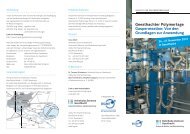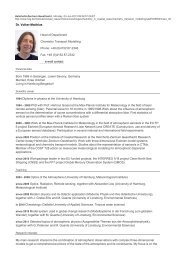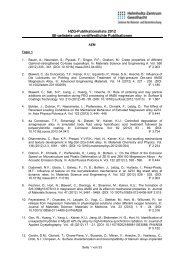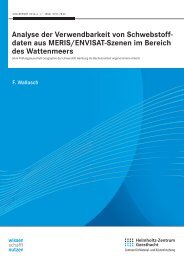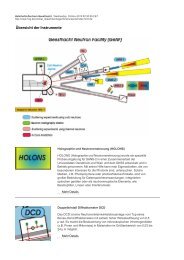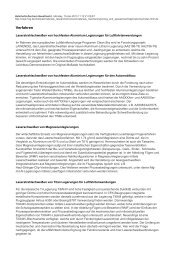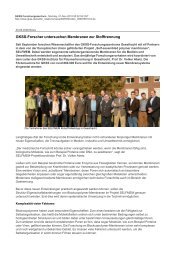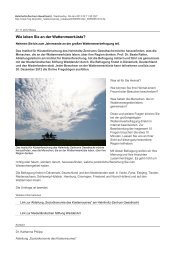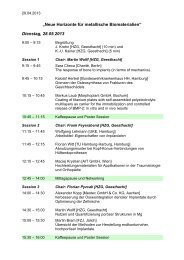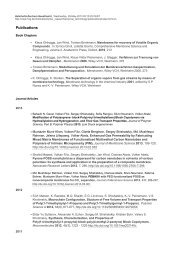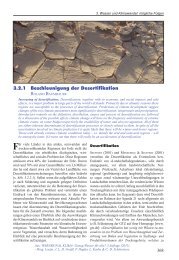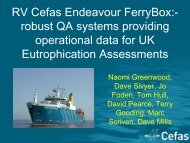High-resolution wave climate analysis in the Helgoland area - GKSS
High-resolution wave climate analysis in the Helgoland area - GKSS
High-resolution wave climate analysis in the Helgoland area - GKSS
Create successful ePaper yourself
Turn your PDF publications into a flip-book with our unique Google optimized e-Paper software.
3.1 Downscal<strong>in</strong>g <strong>in</strong>troduction 25<br />
observed data. The small-scale fields consistent with <strong>the</strong> modeled large-scale situation<br />
can be found directly, apply<strong>in</strong>g <strong>the</strong> derived relationship to <strong>the</strong> large-scale modeled data.<br />
The obvious benefit of <strong>the</strong> empirical methods is <strong>the</strong> computational efficiency with respect<br />
to <strong>the</strong> dynamical approach. The derived <strong>in</strong>ter-scale connections often help to expla<strong>in</strong> or<br />
better understand <strong>the</strong> relations between <strong>the</strong> fields for which <strong>the</strong> physical picture is not<br />
completely clear. Thus, <strong>the</strong> method serves both <strong>the</strong> assessment of <strong>the</strong> small-scale variables<br />
unreachable with <strong>the</strong> dynamical models and <strong>the</strong> <strong>in</strong>vestigation of <strong>the</strong> <strong>in</strong>ter-scale relation<br />
pr<strong>in</strong>ciples. The general limitations of <strong>the</strong> empirical methods comprise <strong>the</strong> necessity of<br />
availability of sufficiently long observed data for <strong>the</strong> empirical model construction and<br />
fulfillment of several assumptions on <strong>the</strong> properties of <strong>the</strong> data and relations. For <strong>the</strong><br />
application of <strong>the</strong> empirical downscal<strong>in</strong>g <strong>the</strong> validity of three conditions is assumed: (a)<br />
<strong>the</strong> large-scale predictors are realistically modeled by <strong>the</strong> global/regional model, (b) <strong>the</strong><br />
relation between large and small scale fields rema<strong>in</strong>s unchanged under <strong>the</strong> chang<strong>in</strong>g <strong>climate</strong><br />
conditions, (c) <strong>the</strong> predictor fully represents <strong>the</strong> <strong>climate</strong> change signal.<br />
The relative simplicity of empirical downscal<strong>in</strong>g methodology, as well as <strong>the</strong> time-sav<strong>in</strong>g<br />
procedure and <strong>the</strong> broad applicability, made <strong>the</strong>m an appropriate tool for re-scal<strong>in</strong>g applications<br />
on various scales and for a wide range of fields. Despite numerous studies and<br />
widespread applications of <strong>the</strong> empirical downscal<strong>in</strong>g, <strong>the</strong>re is no unified gradation of downscal<strong>in</strong>g<br />
techniques accord<strong>in</strong>g to <strong>the</strong>ir abilities. Therefore, for different predictors and predicted<br />
fields, scales (from global to regional, from regional to local) and desired statistical<br />
parameters (e.g. daily or monthly means, seasonal anomalies or yearly extremes, etc.) <strong>the</strong><br />
downscal<strong>in</strong>g models are normally constructed and tested on a case-by-case basis. A review<br />
of downscal<strong>in</strong>g methods, <strong>the</strong>ir prospects and limitations <strong>in</strong> <strong>the</strong> connection to GCM output<br />
downscal<strong>in</strong>g can be found, for example, <strong>in</strong> Wilby and Wigley [1997] or Murphy [1999]. A<br />
review of empirical downscal<strong>in</strong>g techniques and a set of references on recent works concern<strong>in</strong>g<br />
downscal<strong>in</strong>g applications for various fields and scales can be found <strong>in</strong> von Storch et al.<br />
[2000] or <strong>in</strong> IPCC TAR WG1 Section 10.6 (Giorgi et al. [2001]).<br />
Here <strong>the</strong> classification of empirical downscal<strong>in</strong>g methods similar to that <strong>in</strong> IPCC TAR<br />
2001 is briefly presented focus<strong>in</strong>g on <strong>the</strong> methods used fur<strong>the</strong>r <strong>in</strong> <strong>the</strong> study. The variety of<br />
<strong>the</strong> empirical downscal<strong>in</strong>g methods can be grouped <strong>in</strong>to three types. For <strong>the</strong> regression-like<br />
techniques, <strong>the</strong> statistical relation <strong>in</strong> form of transfer functions between <strong>the</strong> s<strong>in</strong>gle po<strong>in</strong>t<br />
or field of large-scale predictor and <strong>the</strong> small-scale predictand is derived. This category<br />
comprises l<strong>in</strong>ear and non-l<strong>in</strong>ear methods. Typical and frequently used l<strong>in</strong>ear techniques<br />
are <strong>the</strong> l<strong>in</strong>ear regression and <strong>the</strong> Canonical Correlation Analysis (CCA). They are applied,<br />
for example, <strong>in</strong> ocean-related studies where <strong>the</strong> relation between sea-level pressure and<br />
monthly sea-level variations (Cui and Zorita [1998]) or yearly sal<strong>in</strong>ity variability (Heyen<br />
and Dippner [1998]) is explored. O<strong>the</strong>r studies were dedicated to <strong>the</strong> model<strong>in</strong>g of extreme<br />
events <strong>in</strong> form of upper monthly or seasonal percentiles of <strong>wave</strong> heights (WASA Group<br />
[1998]) or storm surges (e.g. Langenberg et al. [1999]). The non-l<strong>in</strong>ear approach <strong>in</strong>cludes<br />
models based on artificial neural networks. They are applied when <strong>the</strong> <strong>in</strong>ter-scale relations<br />
are not completely clear or have considerable non-l<strong>in</strong>earities. A neural network is often<br />
more powerful but less <strong>in</strong>terpretable than a l<strong>in</strong>ear method. Examples of applications can



